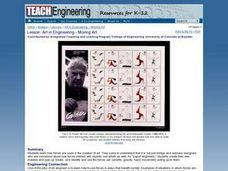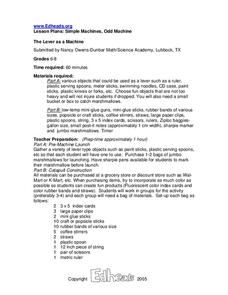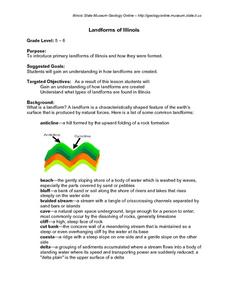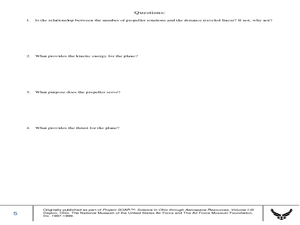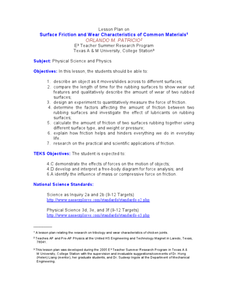Curated OER
Exploring Nature: Powerful Forces
Pupils observe samples of artwork which use line, shape, and form to show movement and depict natural forces of nature. They create their own piece of artwork that shows a natural force and movement and then write a descriptive paragraph...
Curated OER
Forces and Motion Scavenger Hunt
Students determine how force on an object affects its movement. In this force and motion lesson, students take digital pictures of objects in the school setting that are pushed and pulled. They develop a presentation using the digital...
Curated OER
Constructive and Destructive forces
Students explore constructive and destructive forces. In this constructive and destructive forces instructional activity, students complete a WebQuest. Students explore the different types of forces and their effect on the surrounding...
Curated OER
Don't Slip!
Students measure, record, and graph the force of moving a block of wood along sand paper. In this friction lesson plan, students read a spring scale, collect data, construct a graph, and propose a model to explain how fiction works.
Science Companion
Simple Machines Design Project
Make your work as a teacher a little easier with a physical science project on simple machines. After introducing young scientists to these devices and identifying their different uses around the school, this project engages...
Curated OER
Sounds Like Science-Kazoo
Students demonstrate how energy is used to make a sound. In this sound lesson, students construct a kazoo from a comb and identify how a sound is made by using force.
Curated OER
Building Bridges
Learners, in groups, design and test a scale bridge. They use the Internet to research three basic bridge designs -- beam, arch, and suspension -- and the forces that act upon them.
Curated OER
Clouds
Students explore clouds. In this weather lesson, students identify the steps in the water cycle, define condensation and evaporation, and relate this information to cloud formation. Students perform a cloud experiment,...
Curated OER
How to Make a Wind Vane
Students measure the direction of the wind. In this Science lesson, students make their own wind vane. Students discuss the importance of wind direction and speed.
Curated OER
Art in Engineering - Moving Art
Students study how forces are applied in the creation of art. They design mobiles and pop-up books while identifying which forces of nature act upon them. They look at air currents, gravity, and hand movement.
Curated OER
How Wind Works
Second graders investigate the process that creates wind. In this wind lesson, 2nd graders create a wind diagram. Students write an essay to accompany their diagram.
Curated OER
Can You Bear It? Pulleys, Gears, Forces, Structures and Mechanisms
Students review the types of simple machines. As a class, they focus on the positives and negatives of pulleys and gears and identify what pulleys and gears change of an object. They work together to design their own object to support a...
Curated OER
Simple Machines, Odd Machines
Students recognize and identify common objects that can be used as a lever. In this simple machines lesson, students experiment with materials to design and construct a machine that uses a lever. Students also design and build a catapult.
Curated OER
Sediment Sleuths
Are you looking for a good, solid lesson on sedimentary rocks? This one, produced by the Illinois State Museum, is just such a lesson. Middle schoolers identify common rocks and minerals by analyzing sediments from local water sources....
Curated OER
The Math in the Design and Building of Bridges
Research various types of bridge designs. Your class will be asked to consider what it would be like without bridges while learning about how they work. They will construct a model bridge based on given parameters. They then calculate...
Curated OER
Exploring Magnets and Magnetism
Here is a very good lesson on magnets, magnetism, and magnitic fields that is chock full of great activities for you to implement with your young scientists. Learners discover the properties of magnets, look at the forces of attraction...
Curated OER
Landforms of Illinois
Fifth and sixth graders are introduced to the primary landforms of Illinois and discover how they were created. Landform cards are made for each pupil. They use the twenty-questions format until they have identified each one. Then,...
Curated OER
Building a House: Laying a Foundation
Third graders examine how a house is staked when preparing to build while they discover what the foundation is made of. They study how the foundation is poured and that the plumbing is included. They identify the workers and tools used...
Curated OER
Building Bridges
Learners identify the different types of bridges. Using the internet, they research information on how they are built by completing a scavenger hunt. Locating a specific area, they determine which type of bridge would be appropriate and...
Curated OER
Propellers, Forces and Energy
Students construct a model airplane, measure distance, and calculate velocity. In this creative lesson students work in groups to build a model and use it to calculate distances and velocity.
Curated OER
Surface Friction and Wear Characteristics of Common Materials
Students identify the factors affecting friction. In this physics lesson, students construct their own rocket car and race them. They graph the average speeds and discuss how lubricants affect friction between rubbing surfaces.
Curated OER
Clouds
Students recognize the three main types of clouds. In this clouds lesson plan, students create a cloud mobile to understand clouds.
Curated OER
Capturing Wind Energy
Students investigate technology and make a correlation between technology and the weather. In this science lesson, students experiment with the weather and climate using technology to help them understand forces and motion. They identify...
Curated OER
Catherine, Called Birdy: June and July
Students illustrate types of conflicts in Catherine, Called Birdy. For this Catherine, Called Birdy lesson, students take notes on four types of character conflict. Students work in teams to illustrate a conflict...









